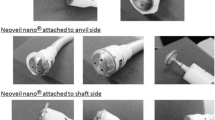Abstract
Several surgical procedures have been proposed to interrupt continuity of the gut, without transection, by means of a row of staples. Using the dog, we investigated the functional and histologic results of incontinuity stapling of the gastric antrum, the small intestine, and the colon. After creation of an end antrostomy, ileostomy, or colostomy, a staple line was placed proximal to the stoma (TA 55-4.8 mm staples). Decompression of the bowel proximal to the staple line was accomplished by an enteric anastomosis. Separation of the staple closure was detected by intestinal contents exiting from the stoma. Animals were sacrificed at the time of disruption, and specimens were obtained for histologic examination.
Three of five antral closures broke down at a mean of 19.6 days after operation. All five small-bowel staple lines opened at a mean of 12.4 days. Five of five colonic staple lines disrupted 13.0 days postoperatively. The staples pulled through the bowel wall without losing their “B” shaped configuration. Microscopic examination showed intact mucosa across the staple line, with no submucosa to submucosa healing.
Staple lines in the undivided small bowel or colon disrupt after approximately two weeks, due to lack of fibrotic healing. Staple interruptions of the gastric antrum also disrupt, but with less regularity.
Similar content being viewed by others
References
Pace WG, Martin EW, Tetirick T, Fabri PJ, Carey LC. Gastric partitioning for morbid obesity. Ann Surg 1979; 190:392–400.
Printen KJ, Mason EE. Gastric surgery for the relief of morbid obesity. Arch Surg 1973; 106:428–31.
Alden JF. Gastric and jejunoileal bypass. Arch Surg 1977; 112: 799–806.
Vaughn DG, Frazier OH, Graham DY, Mattox KL, Petmecky FF, Jordan GL. The use of pyloric exclusion in the management of severe duodenal injuries. Am J Surg 1977; 134:785–90.
Brodman RF, Brodman HR. Defunctionalizing a colostomy. Arch Surg 1975; 110:352.
Ravitch MM, Rivarola A, Vangrov J. Studies of intestinal healing: preliminary studies of the mechanism of healing of everting intestinal anastomosis. Johns Hopkins Med J 1967; 121:343–8.
Ellison EC, Martin EW, Laschinger J, et al. Prevention of early failure of stapled gastric partitions in treatment of morbid obesity. Arch Surg 1980; 115:528–33.
Brolin RE, Ravitch MM. Experimental evaluation of techniques of gastric partitioning for morbid obesity. Surg Gynecol Obstet 1981; 153:877–82.
Author information
Authors and Affiliations
Additional information
This work was accomplished with support from the I.A. O'Shaughnessy Foundation, the Hubbard Foundation, and from Mr. James E. Stewart.
About this article
Cite this article
Mulholland, M.W., Magallanes, F., Quigley, T.M. et al. In-continuity gastrointestinal stapling. Dis Colon Rectum 26, 586–589 (1983). https://doi.org/10.1007/BF02552967
Received:
Issue Date:
DOI: https://doi.org/10.1007/BF02552967




